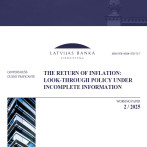Producer prices in support of competitiveness
In April 2013, producer prices posted a slight month-on-month rise (0.1%), which was underpinned by the energy prices going up domestically. In annual terms, however, the growth in producer prices moderated to 1.4% on account of the basis factors in manufacturing, primarily manufacture of basic metals and of products of wood.
Higher energy production costs in the domestic market were spurred by an increase in the mandatory procurement component (MPC) for electricity; as a result, the producer prices recorded an overall month-on-month rise for domestically sold output, while no substantial impact of these price movements on consumer prices was observed. The estimates of electricity cost ratio suggest that the situation in a number of sectors is not critical; hence cost increases could be absorbed.
Along with the unchanging natural gas prices, the producer prices for heating energy remained constant in April, thus restricting the overall producer price rise in the energy sector.
The global price dynamics of the most essential resources has been quite favourable, with the prices of oil and most metals on a downward trend in April; these price movements, however, were set off, in part, by upward price trends for some types of wood (according to www.indexmundi.com) and a moderate increase in the food and agricultural products price index. These factors ensured that producer prices maintained their levels with respect to output for both the domestic market and exports. As the opportunities for overall export growth are currently constrained and the manufacture of basic metals is contracting, labour cost increases in manufacturing are curbed, leaving price competitiveness unaffected.
The global food price developments presently pose some risk to the producer and the related consumer price dynamics. However, despite the pessimistic stances of Latvian grain farmers only in April concerning this year's harvest due to a shorter vegetation period and the looming prospects of re-sowing the already sown fields, the experts from major European grain farming countries, e.g. Russia, the country which has recently revised upward its 2013 harvest forecast, voice a more optimistic outlook for the harvest to come which does not encourage any wider-scale price elevation forecasts. The pressure on grain prices might be reduced, if India's government agrees to expand the country's wheat exports.
Textual error
«… …»






